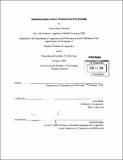| dc.contributor.advisor | Irene Heim. | en_US |
| dc.contributor.author | Howard, Edwin Martin | en_US |
| dc.contributor.other | Massachusetts Institute of Technology. Department of Linguistics and Philosophy. | en_US |
| dc.date.accessioned | 2014-05-23T19:37:17Z | |
| dc.date.available | 2014-05-23T19:37:17Z | |
| dc.date.issued | 2014 | en_US |
| dc.identifier.uri | http://hdl.handle.net/1721.1/87489 | |
| dc.description | Thesis: S.M. in Linguistics, Massachusetts Institute of Technology, Department of Linguistics and Philosophy, February 2014. | en_US |
| dc.description | "February 2014." Cataloged from PDF version of thesis. | en_US |
| dc.description | Includes bibliographical references (page 57). | en_US |
| dc.description.abstract | This paper concerns itself with the superlative morpheme -est and its ability to license Negative Polarity Items (NPIs) such as any or ever, and in particular the compositional analysis of a puzzling type of utterance which incorporates these grammatical elements. Specifically, an embedded clause structure which appears at first glance to be a restrictive relative clause modifier will be argued to be an argument of the superlative morpheme, and an analysis will be presented that brings superlatives in line with comparatives in finding its semantic restrictor in the overt syntax, in the form of a degree clause. The first puzzle comes from an observation about the predictions of von Fintel's 1999 theory of NPI licensing when combined with those of a scope theory of ambiguities in superlative utterances: when -est takes scope at the VP level or higher, it fails to license the particular logical inference (Strawson-Downward Entailment) that von Fintel argues is necessary for NPI licensing. However the target data this paper focuses on seem to present counterevidence to this prediction, as they exhibit NPI licensing by the superlative within what appears to be a relative clause modifier. This puzzle evaporates under the assumption that the embedded clause in question is the degree clause argument of the superlative. Further puzzles arise from unexpected contrasts in felicity and acceptability between minimal pairs of sentences instantiating the superlative degree clause structure. These contrasts are explained under the semantic analysis presented in the paper. It is also demonstrated that the environment where NPIs are interpreted is Strawson-Downward Entailing, in line with von Fintel 1999. NPIs are analysed here as introducing alternatives to create a nontrivial set of degree properties, which provides -est's restrictor, assuming the denotation proposed in Heim 1999. | en_US |
| dc.description.statementofresponsibility | by Edwin Martin Howard. | en_US |
| dc.format.extent | 57 pages | en_US |
| dc.language.iso | eng | en_US |
| dc.publisher | Massachusetts Institute of Technology | en_US |
| dc.rights | M.I.T. theses are protected by copyright. They may be viewed from this source for any purpose, but reproduction or distribution in any format is prohibited without written permission. See provided URL for inquiries about permission. | en_US |
| dc.rights.uri | http://dspace.mit.edu/handle/1721.1/7582 | en_US |
| dc.subject | Linguistics and Philosophy. | en_US |
| dc.title | Superlative degree clauses : evidence from NPI licensing | en_US |
| dc.title.alternative | Superlative degree clauses : evidence from Negative Polarity Item licensing | en_US |
| dc.type | Thesis | en_US |
| dc.description.degree | S.M. in Linguistics | en_US |
| dc.contributor.department | Massachusetts Institute of Technology. Department of Linguistics and Philosophy | |
| dc.identifier.oclc | 879667089 | en_US |
